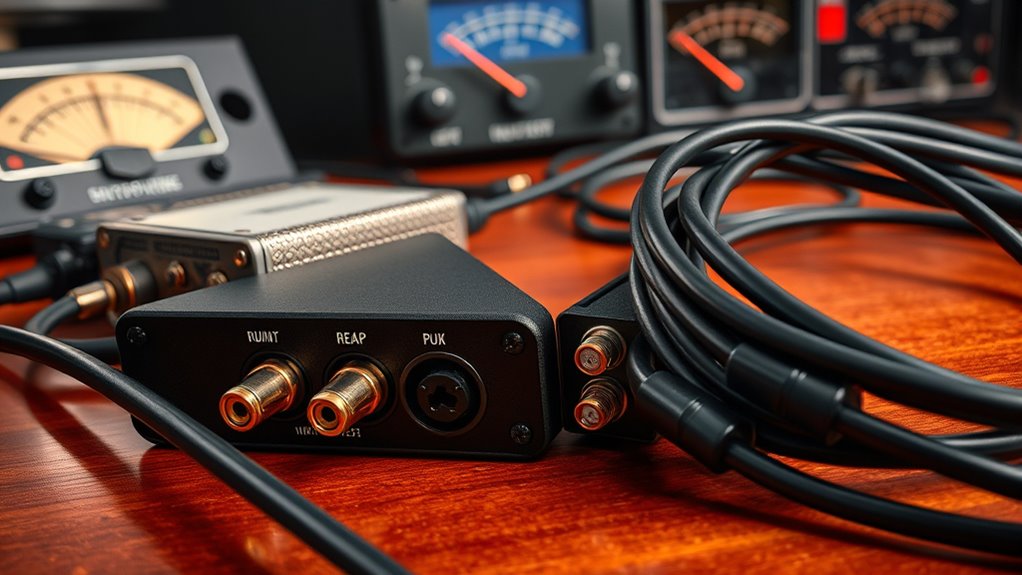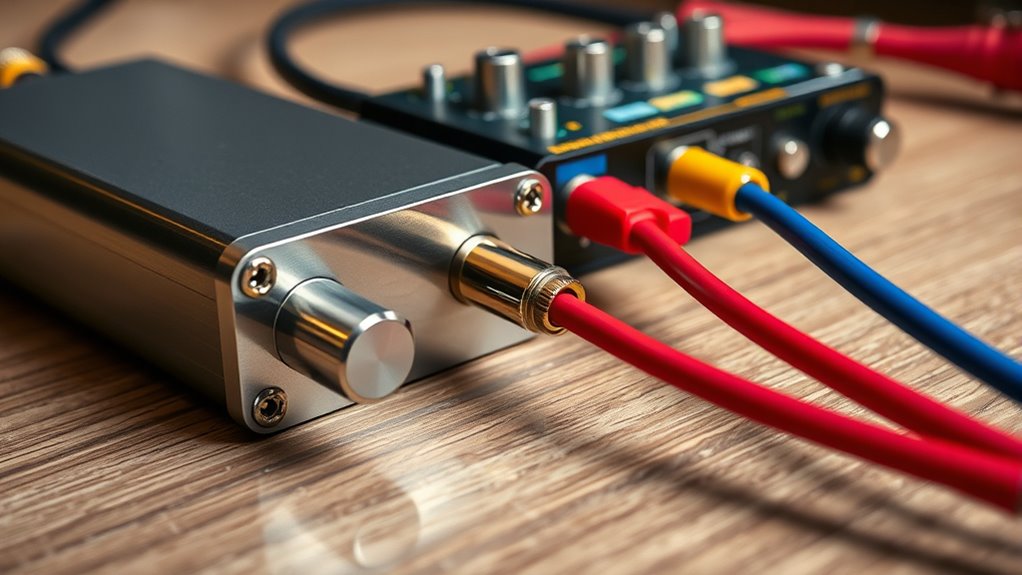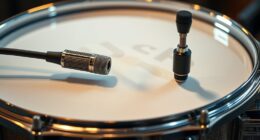To maintain your guitar’s tone, using DI boxes, reamping, and impedance matching is key. DI boxes convert high-impedance guitar signals into low-impedance, balanced outputs, reducing noise and preserving clarity when connecting to mixers or interfaces. Reamping lets you send recorded signals back through gear for tonal adjustments later. Proper impedance matching prevents signal loss and tonal degradation, ensuring your sound stays vibrant. Keep exploring these techniques to master your entire signal chain effectively.
Key Takeaways
- DI boxes convert high-impedance guitar signals to low-impedance, balanced outputs, reducing noise and preserving tone.
- Reamping involves sending recorded signals back through gear using reamp boxes to shape tone post-recording.
- Proper impedance matching prevents signal loss, tonal degradation, and maintains high-frequency detail across gear.
- DI boxes are essential for recording and live sound to ensure clean, balanced, and noise-free signals.
- Reamp techniques allow flexible tone shaping while maintaining consistent, high-quality sound throughout production.

Have you ever wondered how musicians and engineers guarantee their signals sound clear and balanced across different equipment? The secret lies in understanding and managing the signal flow, especially when working with guitar tone and various gear. When your guitar signal travels from your instrument through pedals, amps, and recording interfaces, each piece of equipment can affect the tone and clarity. Proper impedance matching and the use of DI boxes or reamp devices ensure that your signal remains clean, strong, and true to your original sound.
Understanding signal flow and impedance matching keeps your guitar tone clear and balanced across gear.
At the core of maintaining a good signal flow is matching the impedance between your guitar and the subsequent gear. A mismatch can cause a loss of high frequencies, increase noise, or produce a dull tone. For example, passive pickups typically have high impedance, so connecting directly to a long cable or certain pedals may dull your guitar tone. Using a DI (Direct Injection) box helps here by converting your high-impedance guitar signal into a low-impedance, balanced output suitable for mixing consoles or audio interfaces. This process preserves your tone, minimizes noise, and ensures your signal flows smoothly into recording or PA systems.
Reamping is another critical technique used to refine your guitar tone after recording. It involves taking a clean, direct recording of your guitar signal and sending it back through amps, pedals, or speakers to shape the sound later in the production process. Reamp boxes are designed to match the impedance and level of your recorded signal to the gear you’re using for reamping. This flexibility allows you to experiment with different amp settings, effects, or speaker cabinets without playing the guitar again, ensuring your tone remains clear and well-balanced throughout the signal chain.
Impedance matching also plays a essential role in preventing signal loss and tonal degradation. When you connect devices with incompatible impedance levels, you risk losing high frequencies or introducing unwanted noise. Proper matching ensures your guitar tone stays vibrant and detailed, regardless of the gear involved. Whether you’re recording, live performing, or reamping, understanding how to manage impedance and signal flow keeps your sound consistent and professional. Additionally, selecting appropriate audio interface settings can further optimize your signal quality and clarity across different setups.
Frequently Asked Questions
How Do I Choose the Right DI Box for My Instrument?
To choose the right DI box for your instrument, consider its compatibility and power needs. Confirm the DI box matches your instrument type, like electric guitar or bass, and check if it requires phantom power or batteries. Look for a model with solid construction and good reviews to handle your performance environment. Selecting the right DI box helps maintain sound quality, reduces noise, and ensures your instrument sounds its best through the sound system.
Can Impedance Matching Improve My Overall Sound Quality?
Impedance matching can subtly enhance your overall sound quality by ensuring balanced connections and minimizing signal loss. When you match impedances properly, your instrument’s tone stays clear and full, avoiding unwanted noise or dullness. This harmony between components helps your sound flow smoothly, making your performances more polished and professional. So, yes, paying attention to impedance matching can make a noticeable difference in capturing your true musical essence.
What’s the DIfference Between Active and Passive DI Boxes?
Active DI boxes use powered electronics, so they require phantom power and can boost weak signals, making them ideal for long cable runs or low-level sources. Passive DI boxes, on the other hand, don’t need power and rely on transformers, which can cause some signal attenuation but preserve tone better. Choose active if you need gain and additional features, and passive if you want simplicity and purity of sound.
Are There Specific Reamp Devices for Different Guitar Types?
You’ll find that specific reamp devices can indeed make a difference for different guitar types. Imagine your guitar pickups—single-coils or humbuckers—each have unique signals that need just the right touch. Choosing a reamp device tailored to your guitar guarantees compatibility with your amp, capturing nuances and preserving tone. This way, your sound remains true, whether you’re working with vintage amps or modern rigs, elevating your recording game.
How Does Impedance Affect Signal Tone and Clarity?
Impedance considerably impacts your signal tone and clarity by causing impedance mismatch, which can lead to signal degradation. When your guitar’s output impedance doesn’t match the input impedance of your gear, you might notice a duller sound, loss of high frequencies, or unwanted noise. To maintain ideal tone and clarity, verify your equipment’s impedance levels are properly matched, reducing the risk of signal degradation and preserving your guitar’s original sound quality.
Conclusion
Mastering DI, reamp, and impedance matching is like tuning a fine instrument—you’ll uncover clearer, richer sounds that resonate deeply. When you understand how each element interacts, your recordings become more vibrant and professional. Think of these techniques as the bridge connecting your creativity to perfection, ensuring every note hits its mark. Embrace these tools, and watch your music come alive like a symphony that touches the soul.









